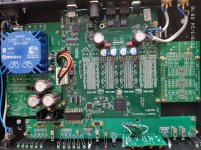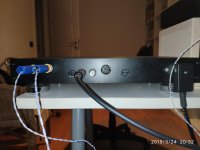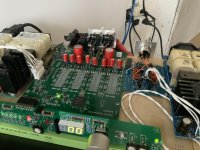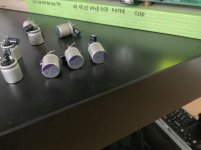Soren,
May I ask: When I use the second I2S input, is the isolator still in use ? My waveio comes with an isolator chip already, so either or to be used ? Any advice on separate power for the input vs. output side ?
The onbaord USB interface is isolated, the 2nd I2S interface is not. The idea is that the 2nd I2S interface is to be connected to a low power computer board with ethernet interface, and therefore isolation is not that important.
I like this a lot...this means that guys like us can use their own isolator/PSU-solution and connect directly to the DAC...which I do currently with the waveio/fifoII/BIII as well.
I plugged the wimas out, which was easy to do...more open IMHO...as my LL1692AM in the tube output will limit bandwidth anyhow.
On the downside, it made clear, that there is a somewhat weird sound (c128 filter) on voices. Unpleasant and flat presentation somwhow.
OK, changed the analog PSU from the stock PSU towards the 0.8uV low noise PSU from DIYINHK 0.8uV Ultralow noise DAC power supply regulator 3.3/5/7V 1.5A*x2 - DIYINHK based on LT3042.
Result: The weirdness in the voices is gone nearly completely. Very nice. Still a little veiled IMHO, but a different analog supply is a must...will play with this area further...
Next: latest version of the WAVEIO with upgrade clocks etc as input on the I2S...
I plugged the wimas out, which was easy to do...more open IMHO...as my LL1692AM in the tube output will limit bandwidth anyhow.
On the downside, it made clear, that there is a somewhat weird sound (c128 filter) on voices. Unpleasant and flat presentation somwhow.
OK, changed the analog PSU from the stock PSU towards the 0.8uV low noise PSU from DIYINHK 0.8uV Ultralow noise DAC power supply regulator 3.3/5/7V 1.5A*x2 - DIYINHK based on LT3042.
Result: The weirdness in the voices is gone nearly completely. Very nice. Still a little veiled IMHO, but a different analog supply is a must...will play with this area further...
Next: latest version of the WAVEIO with upgrade clocks etc as input on the I2S...
Last edited:
Junked the stock PS. Wow, what an improvement! It is now very similar to my 1021 with a bit more solidity in the midbass and better ability to handle peaks. Beginning to sound very promising 🙂
Junked the stock PS. Wow, what an improvement! It is now very similar to my 1021 with a bit more solidity in the midbass and better ability to handle peaks. Beginning to sound very promising 🙂
Err - what did you do actually?
I just junked Vref caps an replaced them with BG N 10/50. I might be imagining things, but it seems like everything sounds so much better now. Gone is the slight edginess, the texture and definition of the bass, rhythm are all better, very impressive low level detail and overall presentation much more natural. While before, the DAC sounded promising, it entered brand new territory now. I will be still experimenting with those caps, but for now I’m quite satisfied with a sound.
Attachments
...Peter, what are the big red guys ? Looks like BG as well, no ? Any source for the Bg N 10/50 ?
This thread gets really some momentum...very nice....
This thread gets really some momentum...very nice....
Err - what did you do actually?
What i wrote: removed the stock board and added separate transformers and lots of Mlytics. Like PD, only uglier 🙂
it entered brand new territory now.
It also entered a brand new price bracket. Those are NX, right? 😀
All red caps are N type, the bigger ones are 100/50
And yes, all those BGs are worth more than the DAC board itself ;-)
And yes, all those BGs are worth more than the DAC board itself ;-)
Peter, do I get this right...you replace the 1000uF / 10V with 10uF /50 V caps ? That would be quiet a change in values...
All red caps are N type, the bigger ones are 100/50
And yes, all those BGs are worth more than the DAC board itself ;-)
I would call that a big step back compared with the mounted 1000u polymers, could be one of the typical cases where you want your mod to be better....
If you want to add your magical capacitors, keep the original and parallel new ones....
But the whole idea for the dam19x1 is for DIY'er to experiments, especially on the power supplies and output buffers, the accessory boards are just to be used as a starting points....
Peter, do I get this right...you replace the 1000uF / 10V with 10uF /50 V caps ? That would be quiet a change in values...
Yes, that’s exactly what I did and it works perfectly fine for me. That choice was inspired by my past experience with my own DAC design where smaller caps produced better results.
I also tried OsCons here briefly, and they produced marginally better results than stock polymer caps, but it was nothing like the change I’m experiencing with those small caps.
Attachments
Last edited:
But why those expensive BG then ? There are real polyprops at a nicer price point around, no ? But its interesting that these areas are identified to change the sound...so if one chooses to go wild, why not a couple of CDE 947D...they really sound transparent...serious stuff, big like a COKE-can...
I just happen to have a good stock of them and use them when occasion arise. I would never pay current prices. As pointed previously, the OsCons may be a good alternative.
Forget big polyprops, they may be good for speaker crossovers, but not here. BTW, there were very few polypropylene I found better in signal coupling than 4.7uF BG N.
Forget big polyprops, they may be good for speaker crossovers, but not here. BTW, there were very few polypropylene I found better in signal coupling than 4.7uF BG N.
I would call that a big step back compared with the mounted 1000u polymers, could be one of the typical cases where you want your mod to be better....
If you want to add your magical capacitors, keep the original and parallel new ones....
But the whole idea for the dam19x1 is for DIY'er to experiments, especially on the power supplies and output buffers, the accessory boards are just to be used as a starting points....
I’v been refraining myself from touching caps on main board since November last year, but curiosity finally took over.
What is the actual purpose of such high capacitance? I would call it a typical case when one thinks more is better.
Paralleling caps never works well, choose one good cap and leave it alone, otherwise the inferior one will mask the virtues of the better one.
I’m not claiming those are magical caps, I just happen to like them in digital circuits and they always worked well for me: Pushing the limits of TDA1543 NOS DAC
Besides, I DID say:
I might be imagining things....
Last edited:
I’v been refraining myself from touching caps on main board since November last year, but curiosity finally took over.
What is the actual purpose of such high capacitance? I would call it a typical case when one thinks more is better.
Paralleling caps never works well, choose one good cap and leave it alone, otherwise the inferior one will mask the virtues of the better one.
An important thing on DACs is low impedance on the vrefs at frequencies from DC to Mhz, especially on a R-2R DAC where output is directly related to the vrefs. The importance of that have been discussed many many times on the dam1021 thread.
The dam190x1 have opamps being used as regulators, those closed loop output impedance start to rise at 10 Khz, there the capacitors take over, simulations showed that a 1000u polymer was an excellent choice, not a random choice. That one have low impedance up to several hundreds Khz, where then a number of ceramics take over, both large and small, low inductance is also important, what's why 0402 sizes are good too.
Paralleling capacitors works very good, that way you can get low impdance and inductance over a large frequency range. And only low impedance count on vref decopling, any magic caps are a waste if their specs don't match the needs. My taget is 10 mOhm from DC to Mhz.
Last edited:
Ok, if I understand this right, Soren is confirming that the Vrefs caps are very critical to how this DAC sounds in general, right ?
So, my next question would be: Is the requirement to go low impedance from DC up to Mhz coming from playing DSD ? Or the other way around: If one is only playing pcm up to 192khz, can we get rid of those ceramic caps (which I would find suspious first before touching the 1000uf)?
The other question I would have is: The requirement is 10mOhm, right ? So, the ESR is the important parameter, not the capacitance, right ? I own a couple of larger caps like polyprops or even motor-oiler which sound good and get down to this 10mohm or even lower...the mentioned 947D is clearly a monster (and meant more like a joke), but goes down to 1-1.5mohm....and that at least up to 100khz (where the datasheets ends), so I guess there are some nice polyprops which might fullfill this requirement even into the Mhz area, no ?
So, my next question would be: Is the requirement to go low impedance from DC up to Mhz coming from playing DSD ? Or the other way around: If one is only playing pcm up to 192khz, can we get rid of those ceramic caps (which I would find suspious first before touching the 1000uf)?
The other question I would have is: The requirement is 10mOhm, right ? So, the ESR is the important parameter, not the capacitance, right ? I own a couple of larger caps like polyprops or even motor-oiler which sound good and get down to this 10mohm or even lower...the mentioned 947D is clearly a monster (and meant more like a joke), but goes down to 1-1.5mohm....and that at least up to 100khz (where the datasheets ends), so I guess there are some nice polyprops which might fullfill this requirement even into the Mhz area, no ?
Last edited:
An important thing on DACs is low impedance on the vrefs at frequencies from DC to Mhz, especially on a R-2R DAC where output is directly related to the vrefs. The importance of that have been discussed many many times on the dam1021 thread.
The dam190x1 have opamps being used as regulators, those closed loop output impedance start to rise at 10 Khz, there the capacitors take over, simulations showed that a 1000u polymer was an excellent choice, not a random choice. That one have low impedance up to several hundreds Khz, where then a number of ceramics take over, both large and small, low inductance is also important, what's why 0402 sizes are good too.
Paralleling capacitors works very good, that way you can get low impdance and inductance over a large frequency range. And only low impedance count on vref decopling, any magic caps are a waste if their specs don't match the needs. My taget is 10 mOhm from DC to Mhz.
Thanks for the explanation. So how was it done in dam1021, which I also have, and with few simple mods it sounded quite good?
Attachments
I guess there are some nice polyprops which might fullfill this requirement even into the Mhz area, no ?
The only films that can manage this are the Panasonic ECPU. No leaded or wound part is likely to be any good at high frequencies due to the added inductance.
But yes, those ceramics are very tempting to discard.
- Home
- Vendor's Bazaar
- dam1941 - Next Gen Discrete R-2R Sign Magnitude 24 bit 384 kHz DAC module





